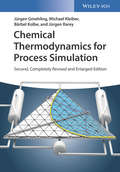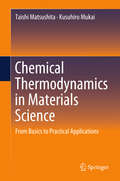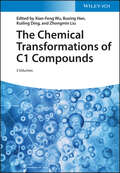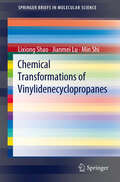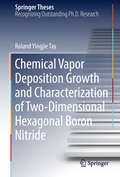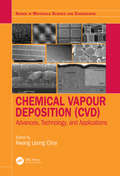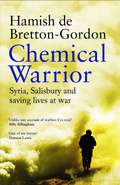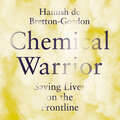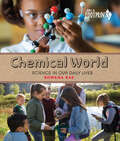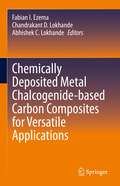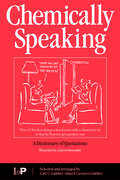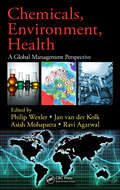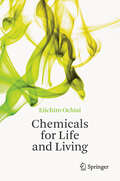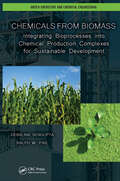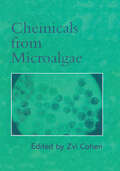- Table View
- List View
Chemical Thermodynamics and Information Theory with Applications
by Daniel J. GrahamThermodynamics and information touch theory every facet of chemistry. However, the physical chemistry curriculum digested by students worldwide is still heavily skewed toward heat/work principles established more than a century ago. Rectifying this situation, Chemical Thermodynamics and Information Theory with Applications explores applications dra
Chemical Thermodynamics for Process Simulation
by Jürgen Gmehling Michael Kleiber Bärbel Kolbe Jürgen RareyThe only textbook that applies thermodynamics to real-world process engineering problems This must-read for advanced students and professionals alike is the first book to demonstrate how chemical thermodynamics work in the real world by applying them to actual engineering examples. It also discusses the advantages and disadvantages of the particular models and procedures, and explains the most important models that are applied in process industry. All the topics are illustrated with examples that are closely related to practical process simulation problems. At the end of each chapter, additional calculation examples are given to enable readers to extend their comprehension. Chemical Thermodynamics for Process Simulation instructs on the behavior of fluids for pure fluids, describing the main types of equations of state and their abilities. It discusses the various quantities of interest in process simulation, their correlation, and prediction in detail. Chapters look at the important terms for the description of the thermodynamics of mixtures; the most important models and routes for phase equilibrium calculation; models which are applicable to a wide variety of non-electrolyte systems; membrane processes; polymer thermodynamics; enthalpy of reaction; chemical equilibria, and more. -Explains thermodynamic fundamentals used in process simulation with solved examples -Includes new chapters about modern measurement techniques, retrograde condensation, and simultaneous description of chemical equilibrium -Comprises numerous solved examples, which simplify the understanding of the often complex calculation procedures, and discusses advantages and disadvantages of models and procedures -Includes estimation methods for thermophysical properties and phase equilibria thermodynamics of alternative separation processes -Supplemented with MathCAD-sheets and DDBST programs for readers to reproduce the examples Chemical Thermodynamics for Process Simulation is an ideal resource for those working in the fields of process development, process synthesis, or process optimization, and an excellent book for students in the engineering sciences.
Chemical Thermodynamics for Process Simulation
by Jürgen Gmehling Michael Kleiber Bärbel Kolbe Jürgen RareyThe only textbook that applies thermodynamics to real-world process engineering problems This must-read for advanced students and professionals alike is the first book to demonstrate how chemical thermodynamics work in the real world by applying them to actual engineering examples. It also discusses the advantages and disadvantages of the particular models and procedures, and explains the most important models that are applied in process industry. All the topics are illustrated with examples that are closely related to practical process simulation problems. At the end of each chapter, additional calculation examples are given to enable readers to extend their comprehension. Chemical Thermodynamics for Process Simulation instructs on the behavior of fluids for pure fluids, describing the main types of equations of state and their abilities. It discusses the various quantities of interest in process simulation, their correlation, and prediction in detail. Chapters look at the important terms for the description of the thermodynamics of mixtures; the most important models and routes for phase equilibrium calculation; models which are applicable to a wide variety of non-electrolyte systems; membrane processes; polymer thermodynamics; enthalpy of reaction; chemical equilibria, and more. -Explains thermodynamic fundamentals used in process simulation with solved examples -Includes new chapters about modern measurement techniques, retrograde condensation, and simultaneous description of chemical equilibrium -Comprises numerous solved examples, which simplify the understanding of the often complex calculation procedures, and discusses advantages and disadvantages of models and procedures -Includes estimation methods for thermophysical properties and phase equilibria thermodynamics of alternative separation processes -Supplemented with MathCAD-sheets and DDBST programs for readers to reproduce the examples Chemical Thermodynamics for Process Simulation is an ideal resource for those working in the fields of process development, process synthesis, or process optimization, and an excellent book for students in the engineering sciences.
Chemical Thermodynamics in Materials Science: From Basics to Practical Applications
by Taishi Matsushita Kusuhiro MukaiThis textbook covers chemical thermodynamics in materials science from basic to advanced level, especially for iron and steel making processes.To improve a process by applying knowledge of thermodynamics or to assess the calculation results of thermodynamic software, an accurate and systematic understanding of thermodynamics is required. For that purpose, books from which one can learn thermodynamics from the basic to the advanced level are needed, but such books are rarely published. This book bridges the gap between the basics, which are treated in general thermodynamic books, and their application, which are only partially dealt with in most specialized books on a specific field.This textbook can be used to teach the basics of chemical thermodynamics and its applications to beginners. The basic part of the book is written to help learners acquire robust applied skills in an easy-to-understand manner, with in-depth explanations and schematic diagrams included. The same book can be used by advanced learners as well. Those higher-level readers such as post-graduate students and researchers may refer to the basic part of the book to get down to the basic concepts of chemical thermodynamics or to confirm the basic concepts. Abundant pages are also devoted to applications designed to present more advanced applied skills grounded in a deep understanding of the basics. The book contains some 50 examples and their solutions so that readers can learn through self-study.
The Chemical Transformations of C1 Compounds
by Xiao-Feng Wu Buxing Han Kuiling Ding Zhongmin LiuThe Chemical Transformations of C1 Compounds A comprehensive exploration of one-carbon molecule transformations The chemistry of one-carbon molecules has recently gained significant prominence as the world transitions away from a petroleum-based economy to a more sustainable one. In The Chemical Transformations of C1 Compounds, an accomplished team of chemists delivers an in-depth overview of recent developments in the field of single-carbon chemistry. The three-volume book covers all major C1 sources, including carbon monoxide, carbon dioxide, methane, methanol, formic acid, formaldehyde, carbenes, C1 halides, and organometallics. The editors have included resources discussing the main reactions and transformations into feedstock chemicals of each of the major C1 compounds reviewed in dedicated chapters. Readers will discover cutting-edge material on organic transformations with MeNO2, DMF, DCM, methyl organometallic reagents, CCl4, CHCl3, and CHBr3, as well as recent achievements in cyanation reactions via cross-coupling. The book also offers: Thorough introductions to chemical transformations of CH4, methods of CH4 activation, chemical transformations of CH3OH and synthesis alkenes from CH3OH Comprehensive explorations of the carbonylation of MeOH, CH2O in organic synthesis, organic transformations of HCO2H, and hydrogen generation from HCO2H Practical discussions of the carbonylation of unsaturated bonds with heterogeneous and homogeneous catalysts, as well as the carbonylation of C(sp2)-X bonds and C(sp3)-X bonds In-depth examinations of carbonylative C-H bond activation and radical carbonylation Perfect for organic and catalytic chemists, The Chemical Transformations of C1 Compounds is also an ideal resource for industrial chemists, chemical engineers, and practitioners at energy supply companies.
Chemical Transformations of Vinylidenecyclopropanes (SpringerBriefs in Molecular Science)
by Min Shi Jianmei Lu Lixiong ShaoModern organic synthesis has paid much attention to the chemistry of small carbocycles. Vinylidenecyclopropanes (VDCPs), which have strained cyclopropyl group connected with an allene moiety and yet are thermally stable and reactive substances in organic chemistry, are versatile intermediates in organic synthesis. In this volume, Dr. Lixiong Shao, Dr. Jianmei Lu and Prof. Dr. Min Shi review their investigations on the chemistry of VDCPs, mainly including the preparation, the reactivities upon treatment with Lewis or Brønsted acid, as well as transition metal catalysts and some other miscellaneous analogues. The contributions aroused a renaissance of cationic intermediates in the chemistry of VDCPs.
Chemical Vapor Deposition Growth and Characterization of Two-Dimensional Hexagonal Boron Nitride (Springer Theses)
by Roland Yingjie TayThis thesis focuses on the growth of a new type of two-dimensional (2D) material known as hexagonal boron nitride (h-BN) using chemical vapor deposition (CVD). It also presents several significant breakthroughs in the authors’ understanding of the growth mechanism and development of new growth techniques, which are now well known in the field. Of particular importance is the pioneering work showing experimental proof that 2D crystals of h-BN can indeed be hexagonal in shape. This came as a major surprise to many working in the 2D field, as it had been generally assumed that hexagonal-shaped h-BN was impossible due to energy dynamics. Beyond growth, the thesis also reports on synthesis techniques that are geared toward commercial applications. Large-area aligned growth and up to an eightfold reduction in the cost of h-BN production are demonstrated. At present, all other 2D materials generally use h-BN as their dielectric layer and for encapsulation. As such, this thesis lays the cornerstone for using CVD 2D h-BN for this purpose.
Chemical Vapour Deposition: Advances, Technology and Applications (Series in Materials Science and Engineering)
by Kwang-Leong ChoyThis book offers a timely and complete overview on chemical vapour deposition (CVD) and its variants for the processing of nanoparticles, nanowires, nanotubes, nanocomposite coatings, thin and thick films, and composites. Chapters discuss key aspects, from processing, material structure and properties to practical use, cost considerations, versatility, and sustainability. The author presents a comprehensive overview of CVD and its potential in producing high performance, cost-effective nanomaterials and thin and thick films. Features Provides an up-to-date introduction to CVD technology for the fabrication of nanomaterials, nanostructured films, and composite coatings Discusses processing, structure, functionalization, properties, and use in clean energy, engineering, and biomedical grand challenges Covers thin and thick films and composites Compares CVD with other processing techniques in terms of structure/properties, cost, versatility, and sustainability Kwang-Leong Choy is the Director of the UCL Centre for Materials Discovery and Professor of Materials Discovery in the Institute for Materials Discovery at the University College London. She earned her D.Phil. from the University of Oxford, and is the recipient of numerous honors including the Hetherington Prize, Oxford Metallurgical Society Award, and Grunfeld Medal and Prize from the Institute of Materials (UK). She is an elected fellow of the Institute of Materials, Minerals and Mining, and the Royal Society of Chemistry.
Chemical Warrior: Syria, Salisbury and Saving Lives at War
by Hamish de Bretton-GordonGRIPPING, MOVING AND INSPIRING: the remarkable life of a world-leading expert in chemical weapons defence."Unlike any account of warfare I've read" - Billy BillinghamFor thirty years, Hamish has served and volunteered in conflict zones around the world. As the army's foremost chemical weapons expert, he built a unique first-hand understanding of how to prevent attacks and train doctors on the frontline - saving countless lives in the process.After suffering near-death experiences time and again, Hamish discovered he had a ticking time bomb in his own chest: a heart condition called Sudden Death Syndrome that could kill him at any time. But with a new awareness for the fragility of life, he fought harder to make his count.Despite facing extraordinary personal danger, Hamish has unearthed evidence of multiple chemical attacks in Syria and continues to advise the government at the highest level, including after the 2018 Novichok poisoning in Salisbury. Lifting the lid on Hamish's unique world of battlefield expertise and humanitarian work, Chemical Warrior is a thrilling story of bravery and compassion.
Chemical Warrior: Syria, Salisbury and Saving Lives at War
by Hamish de Bretton-GordonGRIPPING, MOVING AND INSPIRING: the remarkable life of a world-leading expert in chemical weapons defence."Unlike any account of warfare I've read" - Billy BillinghamFor thirty years, Hamish has served and volunteered in conflict zones around the world. As the army's foremost chemical weapons expert, he built a unique first-hand understanding of how to prevent attacks and train doctors on the frontline - saving countless lives in the process.After suffering near-death experiences time and again, Hamish discovered he had a ticking time bomb in his own chest: a heart condition called Sudden Death Syndrome that could kill him at any time. But with a new awareness for the fragility of life, he fought harder to make his count.Despite facing extraordinary personal danger, Hamish has unearthed evidence of multiple chemical attacks in Syria and continues to advise the government at the highest level, including after the 2018 Novichok poisoning in Salisbury. Lifting the lid on Hamish's unique world of battlefield expertise and humanitarian work, Chemical Warrior is a thrilling story of bravery and compassion.
Chemical Warrior: Syria, Salisbury and Saving Lives at War
by Hamish de Bretton-GordonGRIPPING, MOVING AND INSPIRING: the remarkable life of a world-leading expert in chemical weapons defence. "His work has saved lives and given hope." - Professor David Nott, bestselling author of War Doctor For thirty years, Hamish has served and volunteered in conflict zones around the world. As the army's foremost chemical weapons expert, he built a unique first-hand understanding of how to prevent attacks and train doctors on the frontline - saving countless lives in the process. After suffering near-death experiences time and again, Hamish discovered he had a ticking time bomb in his own chest: a heart condition called Sudden Death Syndrome that could kill him at any time. But with a new awareness for the fragility of life, he fought harder to make his count. Despite facing extraordinary personal danger, Hamish has unearthed evidence of multiple chemical attacks in Syria and continues to advise the government at the highest level, including after the 2018 Novichok poisoning in Salisbury. Lifting the lid on Hamish's unique world of battlefield expertise and humanitarian work, Chemical Warrior is a thrilling story of bravery and compassion.(P)2020 Headline Publishing Group Limited
Chemical World: Science in Our Daily Lives (Orca Footprints #17)
by null Rowena RaeDespite people using both natural and synthetic chemicals with (mainly) good intentions, some chemicals have had unintended negative consequences. Chemical residues have contaminated ecosystems the world over and are compromising the health of many ecosystems, animals and humans. The goal of Chemical World: Science in our Daily Lives is to introduce readers to basic chemistry and chemical history, and to show how chemicals are used for particular reasons but sometimes turn out to be harmful to environmental and human health. It invites readers to take a look at the world around them and ask questions about what’s in their environment and how the things they use and eat every day can affect their own health and the planet’s health. Chemical World: Science in Our Daily Lives explores some of the materials—all of which are made of basic chemical elements—that humans use or come into contact with in their day-to-day lives. Some of these chemicals are naturally occurring—clay, mercury, lead. Others have been synthesized by chemists during the past 150 years and used in a bewildering array of products ranging from roof shingles to toothpaste. Many chemical inventions, as well as naturally produced chemicals, have had profound effects on food supply, developing medicines and creating hosts of useful items for modern life. The epub edition of this title is fully accessible.
Chemically Active
by Vicki CobbFun scientific experiments that can be practiced in your home kitchen with simple materials available at your local drug & hardware stores.
Chemically Deposited Metal Chalcogenide-based Carbon Composites for Versatile Applications
by Fabian I. Ezema Chandrakant D. Lokhande Abhishek C. LokhandeThis book satisfies the interest and curiosity of beginners in thin film electrode preparations, characterizations, and device making, while providing insight into the area for experts. The considerable literature on ‘metal chalcogenides based carbon composites and their versatile applications’ reflect its importance for research and demonstrate how it’s now reached a level where the timely review is necessary to understand the current progress and recent trends and future opportunities. In the book, the authors examine recent advances in the state-of-the-art fabrication techniques of metal sulfide based carbon composites along with their working mechanisms, associated issues/solutions, and possible future are discussed. In addition, detailed insight into the properties and various applications including principles, design, fabrication, and engineering aspects are further discussed.
Chemically Imbalanced: Everyday Suffering, Medication, and Our Troubled Quest for Self-Mastery
by Joseph E. DavisA study of how ordinary people deal with everyday problems through self-mastery and mental health care practices.Everyday suffering—those conditions or feelings brought on by trying circumstances that arise in everyone’s lives—is something that humans have grappled with for millennia. But the last decades have seen a drastic change in the way we approach it. In the past, a person going through a time of difficulty might keep a journal or see a therapist, but now the psychological has been replaced by the biological: instead of treating the heart, soul, and mind, we take a pill to treat the brain.Chemically Imbalanced is a field report on how ordinary people dealing with common problems explain their suffering, how they’re increasingly turning to the thin and mechanistic language of the “body/brain,” and what these encounters might tell us. Drawing on interviews with people dealing with struggles such as underperformance in school or work, grief after the end of a relationship, or disappointment with how their life is unfolding, Joseph E. Davis reveals the profound revolution in consciousness that is underway. We now see suffering as an imbalance in the brain that needs to be fixed, usually through chemical means. This has rippled into our social and cultural conversations, and it has affected how we, as a society, imagine ourselves and envision what constitutes a good life. Davis warns that what we envision as a neurological revolution, in which suffering is a mechanistic problem, has troubling and entrapping consequences. And he makes the case that by turning away from an interpretive, meaning-making view of ourselves, we thwart our chances to enrich our souls and learn important truths about ourselves and the social conditions under which we live.Praise for Chemically Imbalanced“Chemically Imbalanced is an excellent addition to the works in social sciences and humanities that examine the distress of ordinary Americans from the second half of the twentieth century onward, a period when commercialized pills and the psychology-based notion of self-improvement entered the minds of Americans.” —Metascience“Chemically Imbalanced raises important questions, offers new insight into the power and reach of the biomedical model and neurobiological thinking, and I highly recommend it. I encourage readers to assign it, especially in graduate-level mental health and illness classes—or any class looking for a discussion on people’s experiences with suffering and the broad impacts of biomedical thinking and treatment.” —Social Forces
Chemically Modified Carbon Nanotubes for Commercial Applications
by Chaudhery Mustansar Hussain Jeenat Aslam Ruby AslamChemically Modified Carbon Nanotubes for Commercial Applications Discover the go-to handbook for developers and application-oriented researchers who use carbon nanotubes in real products Carbon nanotubes have held much interest for researchers since their discovery in 1991. Due to their low mass density, large aspect ratio, and unique physical, chemical, and electronic properties, they provide a fertile ground for innovation in nanoscale applications. The development of chemical modifications that can enhance the poor dispersion of carbon nanotubes in solvents and improve interactions with other materials have enabled extensive industrial applications in a variety of fields. As the chemistry of carbon nanotubes and their functionalization becomes better understood, Chemically Modified Carbon Nanotubes for Commercial Applications presents the most recent developments of chemically modified carbon nanotubes and emphasizes the broad appeal for commercial purposes along many avenues of interest. The book reviews their already realized and prospective applications in fields such as electronics, photonics, separation science, food packaging, environmental monitoring and protecting, sensing technology, and biomedicine. By focusing on their commercialization prospects, this resource offers a unique approach to a significant and cutting-edge discipline. In Chemically Modified Carbon Nanotubes for Commercial Applications readers will also find: Case studies that emphasize the information presented in each chapter Each chapter includes important websites and suggested reading materials Discussion of current applications of the relevant methodologies in every chapter A look at future perspectives in each application area to highlight the scope for next steps within the industry Chemically Modified Carbon Nanotubes for Commercial Applications is a valuable reference for material scientists, chemists (especially those focused on environmental concerns), and chemical and materials engineering scientists working in R&D and academia who want to learn more about chemically modified carbon nanotubes for various scalable commercial applications. It is also a useful resource for a broad audience: anyone interested in the fields of nanomaterials, nanoadsorbents, nanomedicine, bioinspired nanomaterials, nanotechnology, nanodevices, nanocomposites, biomedical application of nanomaterials, nano-engineering, and high energy applications.
Chemically Reacting Flow: Theory, Modeling, and Simulation
by Robert J. Kee Michael E. Coltrin Peter Glarborg Huayang ZhuA guide to the theoretical underpinnings and practical applications of chemically reacting flow Chemically Reacting Flow: Theory, Modeling, and Simulation, Second Edition combines fundamental concepts in fluid mechanics and physical chemistry while helping students and professionals to develop the analytical and simulation skills needed to solve real-world engineering problems. The authors clearly explain the theoretical and computational building blocks enabling readers to extend the approaches described to related or entirely new applications. New to this Second Edition are substantially revised and reorganized coverage of topics treated in the first edition. New material in the book includes two important areas of active research: reactive porous-media flows and electrochemical kinetics. These topics create bridges between traditional fluid-flow simulation approaches and transport within porous-media electrochemical systems. The first half of the book is devoted to multicomponent fluid-mechanical fundamentals. In the second half the authors provide the necessary fundamental background needed to couple reaction chemistry into complex reacting-flow models. Coverage of such topics is presented in self-contained chapters, allowing a great deal of flexibility in course curriculum design. • Features new chapters on reactive porous-media flow, electrochemistry, chemical thermodynamics, transport properties, and solving differential equations in MATLAB • Provides the theoretical underpinnings and practical applications of chemically reacting flow • Emphasizes fundamentals, allowing the analyst to understand fundamental theory underlying reacting-flow simulations • Helps readers to acquire greater facility in the derivation and solution of conservation equations in new or unusual circumstances • Reorganized to facilitate use as a class text and now including a solutions manual for academic adopters Computer simulation of reactive systems is highly efficient and cost-effective in the development, enhancement, and optimization of chemical processes. Chemically Reacting Flow: Theory, Modeling, and Simulation, Second Edition helps prepare graduate students in mechanical or chemical engineering, as well as research professionals in those fields take utmost advantage of that powerful capability.
Chemically Speaking: A Dictionary of Quotations
by Carl C. Gaither Alma E. Cavazos-GaitherIn these days of ever-increasing specialization, it is important to gain a broad appreciation of scientific disciplines such as chemistry. With this in mind, Chemically Speaking: A Dictionary of Quotations contains the words and wisdom of several hundred scientists, writers, philosophers, poets, and academics. Some quotations are illustrated by amu
Chemicals and Fuels from Bio-Based Building Blocks
by Francesco Basile Stefania Albonetti Alessandro Gandini Fabrizio CavaniAn up-to-date and two volume overview of recent developments in the field of chemocatalytic and enzymatic processes for the transformation of renewable material into essential chemicals and fuels. Experts from both academia and industry discuss catalytic processes currently under development as well as those already in commercial use for the production of bio-fuels and bio-based commodity chemicals. As such, they cover drop-in commodity chemicals and fuels, as well as bio-based monomers and polymers, such as acrylic acid, glycols, polyesters and polyolefins. In addition, they also describe reactions applied to waste and biomass valorization and integrated biorefining strategies. With its comprehensive coverage of the topic, this is an indispensable reference for chemists working in the field of catalysis, industrial chemistry, sustainable chemistry, and polymer synthesis.
Chemicals and Methods for Conservation and Restoration: Paintings, Textiles, Fossils, Wood, Stones, Metals, and Glass
by Johannes Karl FinkBefore the 1970s, most information concerning the conservation and restoration of paintings, wood, and archaeological artefacts were focused on the history of the artefacts, previous attempts of conservation, and the future use of these artefacts. The technical methods of how the restoration and conservation were made were dealt with only very briefly. Today, sophisticated methods of scientific analysis such as DNA are common place, and this encourages conservators and scientists to work together to work out the development of new methods for analysis and conservation of artefacts. This book focuses on the chemicals used for conservation and restoration of various artefacts in artwork and archaeology, as well as special applications of these materials. Also the methods used, both methods for cleaning, conservation and restoration, as well as methods for the analysis of the state of the respective artefacts. Topics include oil paintings, paper conservation, textiles and dyes for them, archaeological wood, fossils, stones, metals and metallic coins, and glasses, including church windows.
Chemicals, Environment, Health: A Global Management Perspective
by Philip Wexler Jan van der Kolk Asish Mohapatra Ravi AgarwalThe past 40 years have seen a phenomenal growth in globally oriented public and private initiatives related to chemical and environmental issues. The groundbreaking 1972 United Nations Conference on the Human Environment held in Stockholm was the event responsible for initiating framework for global environmental policies, including those addressin
Chemicals for Life and Living
by Eiichiro OchiaiChemicals often have a negative Image among the general public. But there is no material world or indeed human beings without chemicals. The material world is operated by chemicals. The title 'Chemicals for Life and Living' implies that the material world is staged and played by chemicals. The book consists of five parts and an appendix. Part 1 - Essentials for life; Part 2 - Enhancing health; Part 3 - For the fun of life; Part 4 - Chemistry of the universe and earth, and Part 5 - Some negative effects of chemicals. The appendix gives a brief summary of what chemistry is all about, including a short chapter of chemical principles. No quantitative calculations are included in this book so that it is appealing for everyone - not just chemists.
Chemicals from Biomass: Integrating Bioprocesses into Chemical Production Complexes for Sustainable Development (Green Chemistry and Chemical Engineering)
by Debalina Sengupta Ralph W. PikeChemicals from Biomass: Integrating Bioprocesses into Chemical Production Complexes for Sustainable Development helps engineers optimize the development of new chemical and polymer plants that use renewable resources to replace the output of goods and services from existing plants. It also discusses the conversion of those existing plants into faci
Chemicals from Microalgae
by Zvi CohenThe production of chemicals from microalgae is becoming a significant area of biological research. Chemicals from Microalgae seeks to cover the various aspects that relate to the use of microalgae as a source of chemicals. The chapters discuss the occurrence and physiological role of these chemicals and concentrates on the methods aimed at enhancin
Chemicals in the Food Industry: Toxicological Concerns and Safe Use (SpringerBriefs in Molecular Science)
by Michele Barone Rachid ChaibThis book addresses the use and management of chemicals in the food and beverage industry. The authors explore the use of chemicals as food additives and sanitizers, and provide an overview of their toxicological characterisation with regard to the employees who handle them, and to consumers. In addition, the authors pay special attention to the safe and reliable management of chemicals in the food production and packaging areas, and in quality control laboratories. Topics such as toxicological risks, the importance of labelling, technical and material safety data sheets, risk categories (e.g. fire, explosion, unforeseen chemical reactions, etc.), safe use of hazardous chemicals, prevention procedures, and emergency planning in laboratories and industrial areas are also covered. In closing, readers will learn more about the future behaviour of food-production workers regarding chemical handling and approved uses, especially in light of the recent REACH obligations.Given its scope, the book will appeal not only to researchers interested in food production, food safety, risk prevention and public health, but also to professionals involved in quality control and risk assessment in the food and beverage industry.

